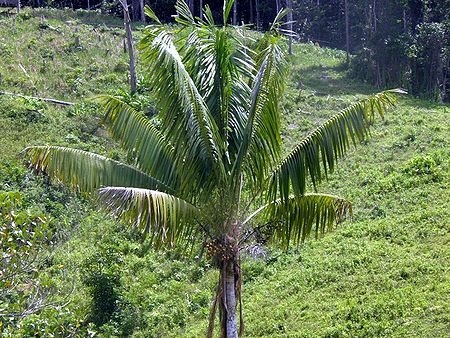Orania paraguanensis
| Orania (oh-rahn-EE-ah) paraguanensis (pah-rah-gwahn-EN-sis) | |||||||
|---|---|---|---|---|---|---|---|
 Hawaii. Photo by Geoff Stein. | |||||||
| Scientific Classification | |||||||
| |||||||
| Synonyms | |||||||
|
| |||||||
| Native Continent | |||||||
|
| |||||||
| Morphology | |||||||
| |||||||
| Culture | |||||||
|
| |||||||
| Survivability index | |||||||
|
| |||||||
| Common names | |||||||
|
| |||||||
Contents
Habitat and Distribution
Borneo, Philippines. Palawan Island, Philippines Archipelago and Banguey Island off the coast of Sabah. Moore (1965) mentioned the presence of this species in mainland Sabah itself - somewhere near Marudi Bay - unfortunately no herbarium specimens are known to exist and the record thus is based on Moore's observation. This species has never been seen in other parts of Borneo. Lowland tropical rainforest. (A.P. Keim and J. Dransfield. 2012)/Palmweb.Description
Large palm. Trunk about 18 - 20 m tall, about 25 - 30 cm in diam. Leaves spirally arranged, about 3 - 4 m long; rachis with about 2.4 - 3 cm in diam. in the middle, glabrous or rarely with red-brown tomentum; leaflets elongate lanceolate, regularly arranged leaflets held in one plane, 60 - 70 in each side of rachis, leaflets c. 6 cm distant, the proximal leaflets not in a group, the most proximal not the smallest, about 97 - 150 cm long, 4.5 - 6 cm wide, adaxial surface glabrous, midrib thick, with thin red-brown tomentum, other ribs slender, glabrous, abaxial surface with dense white indumentum, midrib thicker than adaxial, with thin red-brown tomentum, other ribs slender, glabrous. Inflorescence spreading, branching to 2 orders, rarely to 3 orders (Podzorski 765), glabrous or with thin red-brown tomentum, robust; first order branch about 68 - 70 cm long; rachillae thick, about 35 - 55 cm long, bearing 63 - 100 flower clusters, bearing triads in the proximal 1/5 - 2/5 part, the basal about 2.5 - 3.5 cm devoid of flowers, triads about 2 - 2.5 cm distant, rachilla glabrous, with conspicuously pulvinate base. Staminate flowers with calyx of 3 united minute sepals; corolla with 3 free petals, about 8 mm long, 1.8 - 2 mm wide; stamens always 6, filaments always free, dark brown, about 0.8 - 0.9 mm long, anthers elongate-lanceolate, pale creamy yellow, 6.5 - 8 mm long; pistillodes absent. Pistillate flowers with calyx of 3 united sepals, about 1 mm long; corolla of 3 free petals, about 4 - 6 mm long, 3 - 4 mm wide; staminodes 6, uniform, about ¼ length of gynoecium; gynoecium dark-brown, 2 - 5 mmlong, 1.5 - 4 mm wide, stigma of 3 elongate lobes, about 0.8 - 0.9 mm long. Fruit globose or bilobed, about 3.6 - 5 cm in diam., dull green when young, yellowish green when mature, stigmatic remains subbasal; epicarp smooth, about 1 mm thick; mesocarp fibrous, about 3 - 4 mm thick; endocarp hard, red-brown, about 0.8 - 1 mm thick; testa thinner than endocarp; endosperm, white or creamy white, about 2.75 - 3.5 cm in diam., with hollow about 1 cm in diam. Embryo placed below the middle line of seed. Eophyll pinnate. (A.P. Keim and J. Dransfield. 2012)/Palmweb. Editing by edric.
One specimen (Podzorski 765) has inflorescence branching to 3 orders; however, the rest of the characters match the description of Orania paraguanensis - including the pinnate eophyll. Prior to this study O. paraguanensis was only known from Palawan. It is now known to occur on Banguey Island (now Banggi Island) just off the coast of Sabah and presumably in Sabah itself - somewhere near Marudi (present day Marudi) Bay (Moore 1965). So now there are two species found in Borneo, O. paraguanensis and O. sylvicola. (A.P. Keim and J. Dransfield. 2012)/Palmweb.
Culture
Cold Hardiness Zone: 10b
Comments and Curiosities
Etymology: Genus name; Honors the early 19th century Crown Prince of the Netherlands, F.G.L. Willem van Nassau, Prince of Orange. Species name; From Paragua, Spanish name for Palawan, an island in the Philippines Archipelago.
Conservation: Critically endangered (CR B2a, b). The palm is known from just three localities in Palawan and one in Sabah. We know nothing of its status in Sabah. In Palawan the forest where it grows is subject to intense pressure from mining and land clearance. (A.P. Keim and J. Dransfield. 2012)/Palmweb.
- IMAGE GALLERY
External Links
References
Phonetic spelling of Latin names by edric.
Special thanks to Geoff Stein, (Palmbob) for his hundreds of photos.
Special thanks to Palmweb.org, Dr. John Dransfield, Dr. Bill Baker & team, for their volumes of information and photos.
Glossary of Palm Terms; Based on the glossary in Dransfield, J., N.W. Uhl, C.B. Asmussen-Lange, W.J. Baker, M.M. Harley & C.E. Lewis. 2008. Genera Palmarum - Evolution and Classification of the Palms. Royal Botanic Gardens, Kew. All images copyright of the artists and photographers (see images for credits).
A.P. Keim and J. Dransfield. 2012. A monograph of the genus Orania (Arecaceae: Oranieae).
Many Special Thanks to Ed Vaile for his long hours of tireless editing and numerous contributions.









